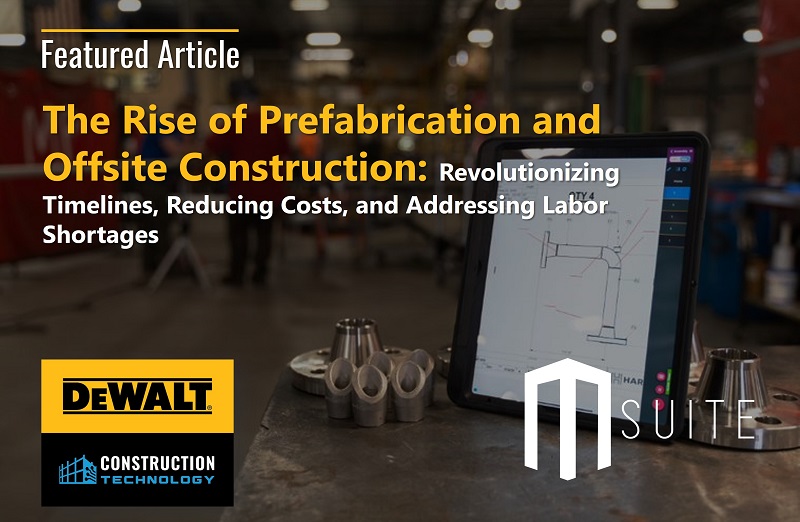The Rise of Prefabrication and Offsite Construction: Revolutionizing Timelines, Reducing Costs, and Addressing Labor Shortages
In recent years, the construction industry has witnessed a transformative shift in how buildings are created with offsite construction. Traditional construction methods, while effective, have often been associated with extended project timelines, budget overruns, and labor shortages. Enter prefabrication and offsite construction, two innovative approaches revolutionizing the construction landscape. These methods are not only changing the way structures are built but also addressing some of the most pressing challenges the industry faces.
Prefabrication and Offsite Construction Defined
Prefabrication involves fabricating building components and systems offsite in a controlled factory environment, followed by assembly on the construction site. On the other hand, offsite construction is a broader concept encompassing various approaches, including prefabrication. It involves carrying out as much work as possible away from the construction site, aiming to streamline processes, improve quality control, and accelerate project delivery.
Types of Projects that Make Sense for Prefabrication
Prefabrication in construction presents a versatile approach quickly applied to various projects, each with unique advantages. Multi-family housing, industrial, commercial, and data center-type projects are ideal candidates for prefabrication due to their often-repetitive nature and the need for cost-effective solutions. The standardized production of components in a controlled factory environment can streamline the construction process, making affordable housing more attainable.
Similarly, off-grid cabins and remote structures benefit from prefabrication’s ability to overcome logistical challenges. Manufacturing and transporting components offsite to remote locations reduces the need for extensive on-site resources and allows for efficient assembly in areas with limited accessibility.
Prefabrication is also well-suited for healthcare facilities, where precision and speed are crucial. The controlled conditions of a factory ensure high-quality components that meet stringent medical standards. As the technology and methods evolve, prefabrication’s versatility ensures its applicability across a broad spectrum of construction projects.
Speeding Up Project Timelines
One of the most significant advantages of prefabrication and offsite construction is their ability to reduce project timelines drastically. Traditional construction methods often involve sequential processes that can lead to delays caused by weather, logistical challenges, and other external factors. Prefabrication eliminates many of these uncertainties. Since the components are manufactured in a controlled environment, weather conditions have minimal impact. Additionally, various tasks, from structural to electrical, mechanical, and plumbing assemblies, can be carried out simultaneously, leading to significant time savings.
Moreover, the assembly process on the construction site is streamlined and efficient, as the prefabricated components are designed to fit together seamlessly and be installed much faster. This expedites the overall construction process, enabling projects to be completed in a fraction of the time it would take using conventional methods.
Cost Efficiency
Prefabrication and offsite construction are not only beneficial in terms of time savings but also cost savings. While the initial investment in factory setup and machinery may be higher, efficiency gains and reduced construction time often offset these costs. Factory production allows for better cost control by ensuring that materials are readily available, designs are repeatable, and minimizes the risk of budget overruns associated with unexpected on-site issues.
Labor costs are also reduced through these methods. Traditional construction often requires a large workforce to be on-site for extended periods. However, prefabrication and offsite construction rely on skilled workers in controlled environments, where productivity is typically higher. This can alleviate the strain of labor shortages that the construction industry frequently faces.
Addressing Labor Shortages
The construction industry has long grappled with a need for more skilled labor. Aging workforces, insufficient training programs, and the job’s physical demands have contributed to a diminishing pool of construction workers. Prefabrication and offsite construction offer a potential solution to this challenge.
With offsite construction, the demand for on-site labor is significantly reduced. The industry can achieve its construction goals with a smaller workforce. Furthermore, since the work environment in a shop setting is often more controlled and less physically demanding, these methods can attract a broader range of individuals to join the construction workforce, including those who the challenges of traditional construction might have deterred.
Quality Control and Sustainability
Prefabrication and offsite construction also offer enhanced quality control. Every component can be constructed to precise specifications in a shop environment, ensuring consistency and quality. This contrasts traditional construction, where factors such as design interpretation and human error on the jobsite can lead to inconsistency.
Sustainability is another aspect where prefabrication and offsite construction excel. The controlled factory-like environment allows for better waste management and recycling practices. Additionally, reducing construction time translates to fewer disruptions to the surrounding environment and energy consumption is often optimized through more efficient production processes.
Conclusion
The rise of prefabrication and offsite construction marks a turning point in the construction industry. These methods offer numerous benefits, including accelerated project timelines, cost efficiency, addressing labor shortages, improved quality control, and enhanced sustainability. While traditional construction methods still have their place, it’s becoming increasingly clear that these innovative approaches are shaping the future of construction. Projects ranging from affordable housing to healthcare facilities are prime candidates for prefabrication. As technology advances and the industry adapts to new demands, prefabrication and offsite construction are poised to play a central role in shaping the skylines of tomorrow.







